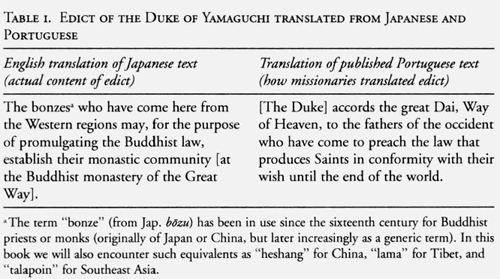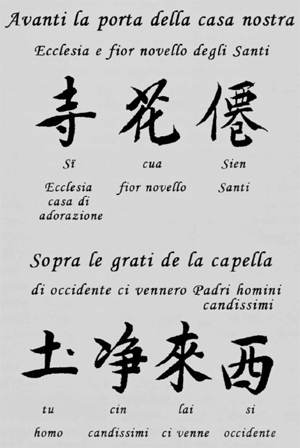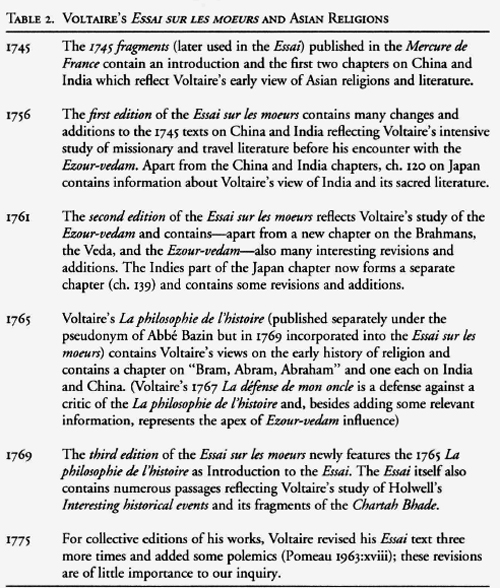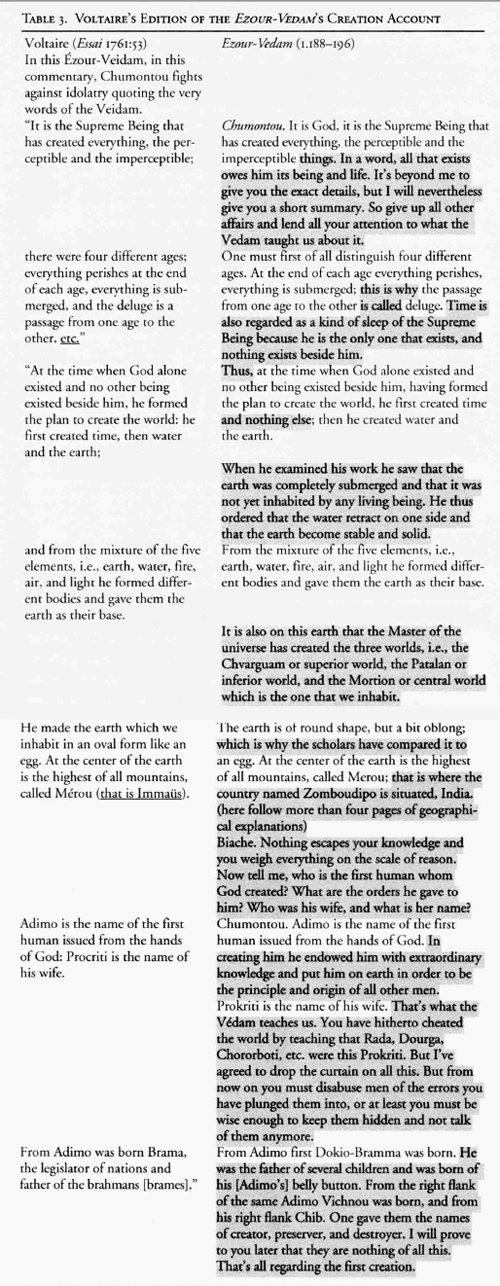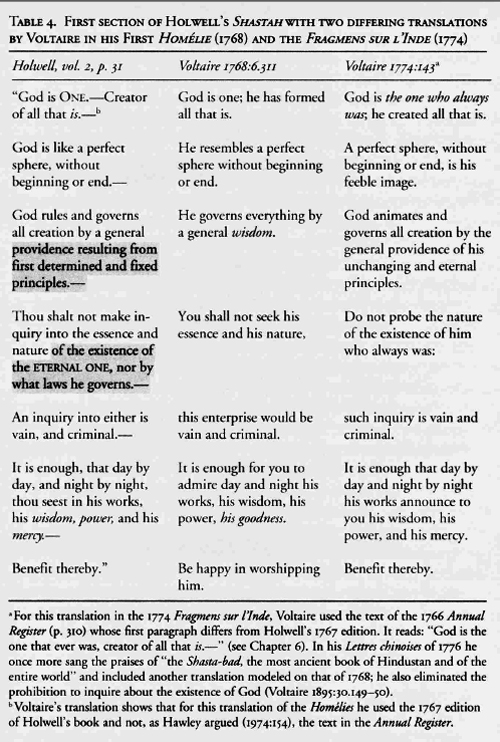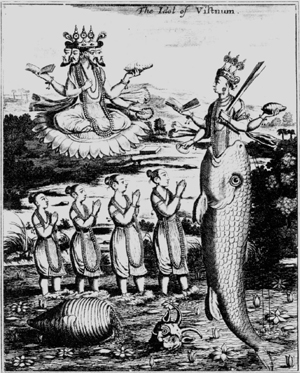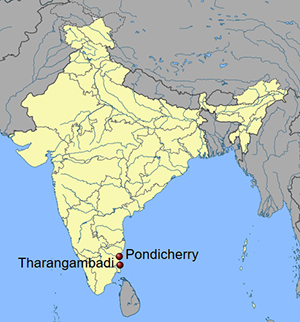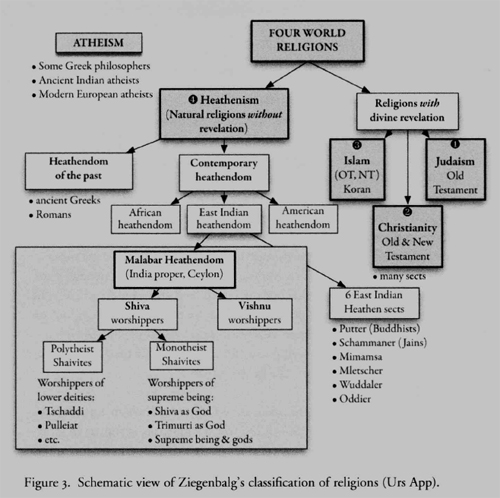Introduction
When a dozen years ago I began to study oriental influences on Richard Wagner's operas in the mid-nineteenth century, I had no idea where my investigations would lead. Having done some research on the Western discovery of Japanese religions in the sixteenth century, it did not take me long to find traces of this discovery in the nineteenth century. But Raymond Schwab's La renaissance orientale and studies on the history of the Western encounter with Asian religions such as Henri de Lubac's La rencontre du bouddhisme et de l'Occident presented an utterly confusing mass of data arranged according to modern notions such as "Buddhism" or "Hinduism" and to modern geographical units such as "India" or "China."
A major reason for this confusion was the fact that the primary sources seem to come from a different world where such neat delimitations do not exist. They tend, for example, to distinguish between esoteric and exoteric "branches" of a pan-Asian religion or to connect the creeds of various countries of "the Indies" to some descendant of Noah. Another factor that complicated matters was the sheer mass of data in many European languages that used different local pronunciations and transcriptions for the same person or thing. Thus, the Portuguese missionaries in Japan often called the Buddha "Xaca," the French missionaries in China "Xekia" or "Foe," the Italians in Vietnam "Thicca," and so on. Some were aware of their identity, others not; and again, others claimed that the Indian god Vishnu, the Persian prophet Zoroaster, or the Egyptian Hermes Trismegistos were alternative names of Buddha. An additional complicating factor was the maze of authors and texts. Trying to distinguish the trailblazers from imitators, embellishers, copyists, and plagiarists turned into a laborious enterprise that involved burrowing through heaps of multilingual literature in libraries on several continents in order to find out where specific items of information came from. This often was difficult. However, patient investigative work over a decade clarified matters to a certain extent and allowed me to isolate a number of ideas, figures, and texts that played key roles in the drawn-out and complex process of the premodern European discovery of Asian religions. These I will present in this introduction.
Key Ideas
I. Esoteric and Exoteric Forms of Religion
One of the ideas repeated in countless European sources about Asian religions is the distinction between "outer" or "exoteric" and "inner" or "esoteric" forms. It was already used in early Christian literature, for example, by Eusebius of Caesarea and Lactantius, to characterize heathen creeds around the Mediterranean. But its roots lie in ancient Greek views of Egyptian religion where Egyptian priests are said to have encoded secret esoteric teachings in hieroglyphs while feeding the outer, exoteric bark of religion to the people. This idea gained renewed popularity in the Renaissance when texts attributed to Hermes Trismegistos ("hermetic texts") were translated into Latin and portrayed as vestiges of ancient Egyptian "esoteric" monotheism. In Europe, this inspired proponents of ancient theology (prisca theologia) like the seventeenth- century Jesuit Athanasius Kircher as well as many missionaries.
Several case studies in this book will show how this notion of esoteric and exoteric teachings allied itself with sixteenth-century reports about Japanese Buddhism and became one of the dominant ideas about Asian religions. The Japanese views, in turn, have roots in Chinese and Indian Buddhism and are thus about as old as their European counterparts. Having heard of this Buddhist distinction in the second half of the sixteenth century, the missionaries to Japan used it to classify the Buddhist sects of that country. At the beginning of the seventeenth century, a long-time resident of Japan, Joao Rodrigues, first applied it to all three major religions of China (which today are called Confucianism, Daoism, and Buddhism). In the 1620s, the Italian Jesuit Cristofo to Borri in Vietnam used the esoteric/exoteric distinction to characterize two phases of the Buddha's life and to classify religious movements in India, Vietnam, China, and Japan. In the course of the seventeenth and eighteenth centuries, this distinction became not only the most conspicuous feature of the Buddha's biography (the story of his deathbed confession) but also the dominant way of explaining the connection between various religions of Asia in terms of esoteric and exoteric branches of a huge pan-Asian religion. The importance of this distinction (as well as of other key ideas mentioned below) for the European discovery of Asian religions cannot be overestimated. It had a far deeper influence than the politico-economic motives that tend to stand in the limelight of current "Orientalism" literature.
Bald assertion in advertising, sometimes referred to as non establishment claim, is a subcategory of a literally false advertising claim. A bald assertion is a statement used in marketing, advertising or promotions by a company without proof or evidence of truth. An example of such advertising practices is when a company claims their product is the best on the market.
-- Bald Assertion, by Wikipedia
2. The Bible-Based Perspective
A fundamental factor in the premodern European discovery of Asian religions is easily overlooked just because it is so pervasive and determines the outlook of most discoverers: the biblical frame of reference. All religions of the world had to originate with a survivor of the great deluge (usually set circa 2500 B.C.E.) because nobody outside Noah's ark survived. In Roman times, young Christianity was portrayed as the successor of Adam's original pure monotheism, thus stretching its roots into antediluvian times. In the Renaissance and its aftermath, Egyptian religion, hermetic texts, and other "ancient" writings such as the Chaldaic oracles were seen as a confirmation of, or a threat to, such claims.
After the discovery of America and the opening of the sea route to India at the end of the fifteenth century, new challenges to biblical authority arose. It was difficult to establish a connection between hitherto unknown people and animals and Noah's ark. But an equally rough nut to crack were the Chinese annals which in the seventeenth century caused much consternation as claims were published that they might be as old as, or even older than, Noah's flood. Our case studies show different ways in which Europeans tried to rise to such challenges: missionaries who attempted to incorporate ancient Asian cultures and religions into Bible-based scenarios; others who tried to move the starting shot of biblical history backward to beat the Chinese annals; people like Isaac La Peyrere and Baruch de Spinoza who concentrated on cracks in the biblical edifice; deists and reformers like Voltaire and John Zephaniah Holwell who attempted to use Asian texts as older and better Old Testaments; and skeptics like Constantin-Francois Volney who came to see the Old Testament as just another outgrowth of the Oriental imagination.
Rise to the challenge: To discover or utilize the strength, determination, or skill necessary to accomplish some difficult task successfully.
I know that you're nervous about taking on such a senior role in the company, but I'm totally confident that you'll rise to the challenge.
The odds were against them, but the home team rose to the challenge and managed to win the championship.
-- Farlex Dictionary of Idioms. © 2015 Farlex, Inc, all rights reserved.
Rise to the challenge: Fig. to accept a challenge. (Usually in reference to success with the challenge.)
You can depend on Kelly to rise to the challenge.
We were not able to rise to the challenge and we lost the contract.
-- McGraw-Hill Dictionary of American Idioms and Phrasal Verbs. © 2002 by The McGraw-Hill Companies, Inc.
Rise to the occasion/challenge: do something successfully in a difficult situation, emergency, etc:
When the lead singer became ill, Cathy had to take her place. Everyone thought she rose to the occasion magnificently.
This company must be prepared to rise to the challenge of a rapidly changing market.
-- Farlex Partner Idioms Dictionary © Farlex 2017
Authors’ Point of View: An author’s point of view refers to his or her position on an issue or, in other words, the author’s opinion or belief regarding an issue.
-- Determing the Author's Purpose, Tone, Point of View, and Intended Audience, by Englishcreek.weebly.com
Asian phenomena and texts, invented or not, were operative not only in the European discovery of Asian religions but also in that of Europe's own religions, languages, and cultures. Just as a people on an isolated island tends to question its own origin and customs only after contact with aliens, Europe's changing worldview and obsession with origins were intimately linked to its confrontation with other cultures and religions -- particularly with non- Abrahamic religions far older than Islam and possibly even than the religion of Abraham. In the course of this confrontation and the crumbling of previous certainties (for example, that Hebrew is the mother of all languages and the Bible the world's most ancient book), even the traditional sequence from initial paradisiacal perfection to the Fall and eventual regeneration came increasingly under attack. The traditional European worldview and even Christianity itself were in danger of being relativized, destabilized, and marginalized. Of course, the discovery of Asian religions was far from the only factor in this process of erosion. But the influence of this discovery on the view of eighteenth-century opinion leaders and innovators such as Pierre Bayle, Giambattista Vico, David Hume, Voltaire, Denis Diderot, Immanuel Kant, and Johann Gottfried Herder is well documented. Nevertheless, it remains little studied. The same can be said of the role of the discovery of Asian religions in the birth of Europe's modern Orientalism. This discovery may appear to be an exotic topic, but in its time it broadened perspectives far more than the Hubble space telescope is expanding ours. It contributed to a change in the very lens apparatus through which the Orient, Europe, the origin of peoples and their cultures, and the world as a whole were seen.
NASA’s Hubble space telescope spots quasar tsunamis ripping across galaxies
Not just traditional religious convictions and ideas about other religions were at stake but the very identity of the Europeans.
Pan-European identity is the sense of personal identification with Europe, in a cultural or political sense ... The model of a "pan-European" union is the Carolingian Empire, which united "Europe" in the sense of Latin Christendom.Saint-Germain-des-Prés is a parish church located in the Saint-Germain-des-Prés quarter of Paris. Founded by Childebert I in the 540s as the Abbaye Sainte-Croix-Saint-Vincent, by the middle of the 8th century it had taken on the name of Saint Germanus (French: Germain), the man appointed bishop of Paris by Childebert and later canonized.
Originally located beyond the outskirts of early medieval Paris, it became a rich and important abbey complex and was the burial place of Germanus and of Childebert and other Merovingian kings of Neustria....A New Manuscript: BN Fonds Francais 19117
In the meanwhile, no one seems to have noticed the existence, in the Bibliotheque Nationale, of a third manuscript of the EzV. The catalogue: Ancien Saint-Germain Francais III. Nos. 18677-20064 du Fonds Francais (by L Auvray and H. Omont, Paris: Leroux, 1900), has the following entry: "19117, 'Zozur Bedo'; traduction francaise du YADJOUR VEDA,4c livre des Vedas. En huit livres. XVIIe-XVIIIe. Papier. ) 58 pages. 208 sur 205 millimetres. Cartonne. (Saint-Germain, Harlay 515.)." This is, indeed, another copy of the EzV, in eight books.
The manuscripts of the Harlay family were donated, by Achille IV de Harlay (died 23 July 1717) to Louis-Germain de Chauvelin (1685-1762), on 11 August 1716.85 The condition attached to the donation said that the manuscripts should stay with de Chauvelin and his male descendants until one of them died without further male descendants "revetus de charge de judicature." [Google translate: load bearing judicature.] At that time the manuscripts were to become the property of the Benedictines of the abbey of Saint-Germain-des-Pres. Chauvelin not only allowed the members of the [Benedictine] Order to use the materials while he still held the usufruct; he also enriched the collection with documents which were his own full property.86 On 19 March 1755 he decided to transfer the collection to Saint-Germain, together with those manuscripts of which he himself was the owner.87 The manuscripts were transferred from the castle of Grosbois to the abbey. They remained a special fund while deposited there, until they were transferred, together with the other manuscripts of Saint-Germain, to the Bibliotheque Nationale, in 1865.88 There the entire collection was integrated into the "Troisieme Serie" of the Fonds Francais: manuscripts 15370 to 20064.89
These data do not entirely solve the problem of the origin of the third EzV manuscript. The donation of 11 August 1716 was accompanied by a catalogue which is, however, lost, with the result that it is no longer possible to ascertain which particular manuscripts were added to the collection by de Chauvelin.90 We can only presume that the EzV did not belong to the original collection of 1716, and that it was one of the latest additions; it is no. 515 in a collection of altogether 519 items. But, even then, the third EzV manuscript must have belonged to the collection by 1755, five years before Maudave brought his copy to Europe.
The principal problem that remains unsolved in all this is that in two handwritten catalogues at the Bibliotheque Nationale, manuscript "Harlay 515" is described as "Melanges cont. 110. pieces": in the "Catalogue des manuscrits de Monsieur** [Chauvelin]",91 and in the "Catalogue des mss. de la bibliotheque de feu Mre Achilles de Harlay, premier president du Parlement de Paris, passes depuis dans la bibliotheque de feu messire Louis- Germain Chauvelin, ancien garde des sceaux, et actuellement dans la bibliotheque de l'abbaye de Saint-Germain-des-Pres, a Paris, 1762."92 [Google translate: Catalog of mss. of the library of the late Mre Achilles de Harlay, first Speaker of Parliament of Paris, since passed in the library of the late Messire Louis-Germain Chauvelin, former Keeper of the Seals, and currently in the library of the Abbey of Saint-Germain-des-Pres, in Paris, 1762.]
Even assuming that the EzV manuscript did belong to the private collection of Louis-Germain de Chauvelin on 19 March 1755, it is no longer possible to investigate how and when he acquired it. The important fact is that it is the oldest EzV manuscript in Europe, even though no one ever took notice of it. It also shows that the terminus ante quem [Google translate: term before he] for the composition of the EzV, which until now was 1759 -- the time when Maudave left India --, has to be advanced with at least five years and possibly by more than that.
-- Ezourvedam: A French Veda of the Eighteenth Century, Edited with an Introduction by Ludo RocherCharlemagne
Clovis converted to Roman Christianity, and an accord was ratified between him and the Roman Church, followed by a great wave of conversion. Clovis was granted the title of New Constantine, presiding over a Holy Roman Empire. Clovis’ successors, however, did not retain his ruthlessness, and instead became mere figureheads, puppets of the Mayors of the Palace, in whose hands was the real power. On Clovis’ death, his son Dagobert, acceded to the kingdom of Austrasia, but was deposed by a conspiracy on the part of Pepin the Fat, the king’s mayor of the palace, which the Church of Rome approved, immediately passing the Merovingian administration of Austrasia to him.
Pepin was followed by Charles Martel, one of the most heroic figures in French history, and who was the grandfather of Charlemagne, according whose name the dynasty came to be known in history as that of the Carolingians. The Carolingians were partly of Merovingian descent, but more importantly, they represented the union of the once divided lineage of the Mithraic bloodline. This lineage had survived in two branches. Julia, the heiress of the Edomite royal bloodline, was the daughter of Herod Phollio King of Chalcis, whose grandfather was Herod the Great, and whose mother was the daughter of Salome, married Tigranes King of Armenia, the son of Alexander of Judea. Their son Alexander married Iotape of Commagene, the daughter of Antiochus IV. From them was descended St. Arnulf, a Frankish noble who had great influence in the Merovingian kingdoms as Bishop of Metz, and who was later canonized as a saint, and who lived from 582 to 640 AD.
In St. Arnulf, this lineage was united with the other branch. That other branch was survived in the priest-kings of Emesa, descended from Claudia, the grand-daughter of the Emperor Claudius, which had also culminated in the person of the Neoplatonic philosopher Iamblichus. Saint Arnulf was the grandfather of Peppin II, the father of Charles Martel.
Charles Martel’s son, Peppin III, was the father of Charles the Great, known as Charlemagne. In 771, Charlemagne assumed the throne and took advantage of his brother’s death to unite the Carolingian territories. Charlemagne’s goal was to unite through conquest all the Germanic people into one kingdom. By 800 AD, the Frankish kingdom included all of modern France, Belgium, Holland, Switzerland, almost all of Germany and large areas of Italy and Spain.
Charlemagne received substantial help from an alliance with the Pope, who wanted to cut the remaining ties with the Byzantine Empire. In this way, the domains of the Pope became an independent state in central Italy. In the same year, 800 AD, Charlemagne was crowned Emperor by the Pope, becoming the first emperor in the west, since the last Roman emperor was deposed in 476 AD, and thus inaugurating the Holy Roman Empire. Charlemagne’s dual role as Emperor, and King of the Franks, provides the historical link between the Frankish kingdoms and later Germany, as both France and Germany look unto Charlemagne as the founding figure of their respective countries.
-- Terrorism and the Illuminati: A Three Thousand Year History, by David Livingston
The tomb of philosopher René Descartes is located in one of the church's side chapels.
-- Saint-Germain-des-Prés (abbey), by Wikipedia
The original proposal for a Paneuropean Union was made in 1922 by Richard von Coudenhove-Kalergi. The term "pan-European" is to be understood not as referring to the modern geographic definition of the continent of Europe but in the historical sense of the western parts of continental Europe sharing the common history of Latin Christendom, the Carolingian Empire and the early modern Habsburg Empire. Coudenhove-Kalergi saw the pan-European state as a future "fifth great power", in explicit opposition to the Soviet Union, "Asia", Great Britain and the United States (as such explicitly excluding both the British Isles and Eastern Europe from his notion of "pan-European").
-- Pan-European identity, by Wikipedia
3. The Oriental System
Boosted by seventeenth-century Jesuits like Rodrigues, Kircher, and Charles Le Gobien, the notion of a pan-Asian "oriental system" or doctrina orientalis with possible Mesopotamian or Egyptian roots became a major factor in eighteenth-century views of Asian religions. Facets of this complex of ideas include theories of an Egyptian origin of Buddhism (Kircher, Mathurin Veyssiere de La Croze, Engelbert Kaempfer, Johann Jacob Brucker, Diderot), the view that Brahmanism is a form of exoteric Buddhism (Diderot, Herder, etc.), the notion that some Buddhist texts of China are translations from the Veda (Joseph de Guignes), and the suspicion that Greek philosophy and particularly Plato were inspired by oriental ideas (A. M. Ramsay) or even by Buddhism (la Crequiniere). The "inner" teachings of this doctrina orientalis were first modeled on the purported monism, emanatism, and "quietism" of Japanese Zen Buddhism and later also of Vedanta and Sufism. In 1688 Francois Bernier linked such oriental quietism to the teachings of Miguel de Molinos, Francois Fenelon, and Madame Guyon as well as the philosophy of Spinoza.
The "Spinoza" article in Bayle's dictionary of 1702 -- one of the most famous and controversial articles in one of the most noted works of eighteenth- century Europe -- is a good example for both the broad use of missionary and secular sources about Asia and the deep influence of the linkage between features of Asian religions and raging theologico-philosophical controversies of Christian Europe. Bayle's influence is palpable not only in Brucker's influential histories of philosophy of the 1730s and 1740s and in Diderot's articles for the Encyclopedie of the 1750s, but also in Johann Lorenz Mosheim's Ecclesiastical History of 1755, Francois Pluquet's Examen du fatalisme of 1757, and many later European works including Herder's philosophy of history (1784-91) and Friedrich Schlegel's pioneering work on the language and wisdom of the Indians (1808). Schlegel, with Volney one of continental Europe's first students of Sanskrit, saw this doctrina orientalis as the ultimate source not only of Oriental philosophy and religion but also of their ancient Greek counterparts (Schlegel 1808:114-23).
At the beginning of the nineteenth century, India had thus for some become not only the cradle of human civilization, as Voltaire had so insistently argued, but of all ancient religion and philosophy -- a notion that inspired Europe's romantic indomania. The birth of modern Orientalism is intimately linked to this idea of Indian origins as an alternative to the biblical narrative. It is not by chance that one of the most ardent propagators after Voltaire of Indian origins was Louis Langles, director of Bible-independent Orientalism's first institution on European soil, the Ecole Speciale des Langues Orientales Vivantes, founded in 1795.
4. Emanation and Transmigration
Bayle (1702), Brucker (1744), Pluquet (1757), F. Schlegel (1808), and many others identified two of the core features of the "oriental doctrine" as emanation and metempsychosis or transmigration of souls. Both were linked to Platonism, pantheism, and Spinozism; thus, they aroused much discussion when all these came under increasing attack. Bayle's 1702 article on Spinoza explicitly established this link in combining information about Greek philosophers and Christian heretics with extensive data from the Orient (Francois Bernier, Philippe Couplet, Simon de La Loubere, Louis Daniel Le Comte, Le Gobien, Antonio Possevino, Guy Tachard) and became a central source not only for Brucker's and Mosheim's discussion of "oriental doctrine" but also for Diderot's article on "philosophie asiatique" (1751) that is discussed in Chapter 3.
From the feeling that society, and indeed 'everything', was in flux, arose, I believe, the fundamental impulse of his philosophy as well as of the philosophy of Heraclitus; and Plato summed up his social experience, exactly as his historicist predecessor had done, by proffering a law of historical development. According to this law, which will be more fully discussed in the next chapter, all social change is corruption or decay or degeneration.
This fundamental historical law forms, in Plato's view, part of a cosmic law — of a law which holds for all created or generated things. All things in flux, all generated things, are destined to decay. Plato, like Heraclitus, felt that the forces which are at work in history are cosmic forces.
It is nearly certain, however, that Plato believed that this law of degeneration was not the whole story. We have found, in Heraclitus, a tendency to visualize the laws of development as cyclic laws; they are conceived after the law which determines the cyclic succession of the seasons. Similarly we can find, in some of Plato's works, the suggestion of a Great Year (its length appears to be 36,000 ordinary years), with a period of improvement or generation, presumably corresponding to Spring and Summer, and one of degeneration and decay, corresponding to Autumn and Winter. According to one of Plato's dialogues (the Statesman), a Golden Age, the age of Cronos — an age in which Cronos himself rules the world, and in which men spring from the earth — is followed by our own age, the age of Zeus, an age in which the world is abandoned by the gods and left to its own resources, and which consequently is one of increasing corruption. And in the story of the Statesman there is also a suggestion that, after the lowest point of complete corruption has been reached, the god will again take the helm of the cosmic ship, and things will start to improve.
It is not certain how far Plato believed in the story of the Statesman. He made it quite clear that he did not believe that all of it was literally true. On the other hand, there can be little doubt that he visualized human history in a cosmic setting; that he believed his own age to be one of deep depravity — possibly of the deepest that can be reached — and the whole preceding historical period to be governed by an inherent tendency toward decay, a tendency shared by both the historical and the cosmical development. Whether or not he also believed that this tendency must necessarily come to an end once the point of extreme depravity has been reached seems to me uncertain. But he certainly believed that it is possible for us, by a human, or rather by a superhuman effort, to break through the fatal historical trend, and to put an end to the process of decay.
Great as the similarities are between Plato and Heraclitus, we have struck here an important difference. Plato believed that the law of historical destiny, the law of decay, can be broken by the moral will of man, supported by the power of human reason.
It is not quite clear how Plato reconciled this view with his belief in a law of destiny. But there are some indications which may explain the matter.
Plato believed that the law of degeneration involved moral degeneration. Political degeneration at any rate depends in his view mainly upon moral degeneration (and lack of knowledge); and moral degeneration, in its turn, is due mainly to racial degeneration. This is the way in which the general cosmic law of decay manifests itself in the field of human affairs.
It is therefore understandable that the great cosmic turning-point may coincide with a turning-point in the field of human affairs — the moral and intellectual field — and that it may, therefore, appear to us to be brought about by a moral and intellectual human effort. Plato may well have believed that, just as the general law of decay did manifest itself in moral decay leading to political decay, so the advent of the cosmic turning-point would manifest itself in the coming of a great law-giver whose powers of reasoning and whose moral will are capable of bringing this period of political decay to a close. It seems likely that the prophecy, in the Statesman, of the return of the Golden Age, of a new millennium, is the expression of such a belief in the form of a myth. However this may be, he certainly believed in both — in a general historical tendency towards corruption, and in the possibility that we may stop further corruption in the political field by arresting all political change. This, accordingly, is the aim he strives for. He tries to realize it by the establishment of a state which is free from the evils of all other states because it does not degenerate, because it does not change. The state which is free from the evil of change and corruption is the best, the perfect state. It is the state of the Golden Age which knew no change. It is the arrested state.
-- The Open Society and Its Enemies, by Karl R. Popper
In the course of the eighteenth century, the old idea that emanation and transmigration had been brought by Pythagoras via Egypt to India got reversed, and India became the ultimate point of origin. Emanation and the thought of a first principle adopting myriad forms had long been linked to the teaching of Buddha, as was the doctrine of transmigration. The idea of the Egyptian origin of such teachings (and by consequence also of Buddhism) -- which had prominent supporters like Kircher (1667), La Croze (1724), Kaempfer (1729), and Brucker (1744) -- lingered on, but in the second half of the eighteenth century, the notion of an Indian cradle carried the day.
Regardless of such controversies about origins, it can be said that, from the sixteenth to the nineteenth centuries, the doctrines of emanation and transmigration constituted a crucial link between East and West extending from Japan in the Far East (where these two ideas had since the sixteenth century been associated by missionaries with the esoteric and exoteric teachings of Xaca or Buddha) via China, Vietnam, Siam, India, and Persia to Egypt and Greece. In the thought of Ramsay (Chapter 5) and Holwell (Chapter 6), this link took on a particularly poignant form since these authors identified transmigration as a most ancient and universal pre-Mosaic teaching concerning the fall of angels before the creation of the earth -- a teaching that in their view forms the initial part of the biblical creation story that Moses omitted. They regarded human souls as the souls of fallen angels imprisoned in human bodies who have to migrate from one body to the next until they achieve redemption and can return to their heavenly home.
Urs App has even suggested that Holwell's basic source was not Indian in origin at all, but a work by Diogo do Couto, Decada Quinta da Asia, from 1612. Based on the observation that Holwell himself confessed to holding heterodox religious views, particularly a conviction in the prophecies of the gnostic preacher Jacob Ilive (1705‐1763), App has traced how Holwell found symmetry between Indian ideas and Ilive's account of an earth populated by fallen angels in do Couto's description of the Vedas, and modelled his Shastah accordingly. To this, the discussion below will add some further detail about the orientation of Holwell's own religious beliefs in order to account for the variety of European sources he brought to bear on his construction of the Shastah....
The above explains how Holwell established an authority through the invention of the Shastah, but the question of why he did so remains. The answer lies in his religious outlook. At a basic level Holwell's comments that all different approaches to the deity should be regarded as ‘divine worship’ and that people of other religions, on encountering a different practice, should ‘revere it still’ certainly suggest that he adopted a latitudinarian position to the point of universalism. This has led many to suggest he was a deist. Others, such as App, have suggested that Holwell's creation of the Shastah was designed to service a Christian ‘reformist ideology’ according to Holwell's confession in the text that, before he arrived in India, he had already become ‘a thorough convert’ to the hypotheses of the neo‐Gnostic prophet of eighteenth‐century London, Jacob Ilive. But while Ilive did indeed have an impact on the shape of Holwell's thought, Holwell's Dissertation drew on a range of religiously heterodox European discourses which covered Locke and Leibniz, as well as exploring in greater detail the ideas of various theologians, such as Capel Berrow (1716‐1782) and the Cambridge Platonists. Moreover, we have to take seriously Holwell's claim in the third volume (1771) of Interesting Historical Events that his was the perspective of a ‘Christian deist’. To understand what he meant by this we have to consider the title of the first edition of the text, which promised both an account of ‘The Mythology and Cosmogony, Facts and Festivals of the Gentoos, Followers of the SHASTAH’ and ‘A Dissertation on the doctrine of METEMPSYCHOSIS’.
To Ilive's central claim, that this earth was designed for the rehabilitation of banished angels, Holwell added ‘the doctrine of Metempsychosis’, of which Ilive had been ignorant. Metempsychosis, a term taken from Greek philosophy, refers to the movement of the soul between bodies after physical death. According to Holwell, these ideas had originated with the Shastah, spread by both Pythagoras and Zoroaster, and ‘truly bore the stamp of divine!’. In subsequent years, however, the adaptation of these theories to diverse religious interests and innovations resulted in them becoming ‘wild and incomprehensible!’. The spread and eventual obscurity of the doctrine of metempsychosis thus features as a parallel narrative of decline, outside India, to that of the ‘Gentoo’ religion away from the original Shastah within. The Shastah that Holwell laid out before the public was thus a creation story. It revealed that ‘the Eternal One’ had created the triumvirate of Birmah, Bistnoo, Sieb (Brahmā, Viṣṇu, Śiva) and then Maisasoor (taken from the ‘buffalo demon’ figure Mahīśāsura), followed by a host of angelic beings. In Holwell's account Maisasoor instigated a rebellion among the lower deities, the Debtah‐Logue (devatāloka), in response to which the ‘Eternal One’ condemned them to eternal punishment. With the intervention of Bistnoo this was altered to offer the prospect of returning to grace by earning salvation through successive states of existence, transmigrating through eighty‐eight different forms, the last two stages of which were Ghoji (cow) and Mhurd (man). Consequently, humanity was in fact made up of the spirits of delinquent angels, whose duty it was to purify themselves through a virtuous life (which included vegetarianism). This was the doctrine of metempsychosis. For Holwell it had the advantage of solving some troublesome theological problems, such as the not so insignificant matter of theodicy. The idea that earthly punishments were the just consequences of a pre‐existent lapse, in the form of an angelic rebellion, solved the seemingly incongruous idea of a benevolent God and the admission of moral evil into the world. Thus, in offering his commentary in 1767, he admits that he had ‘hitherto met with no solution of this interesting enquiry, so satisfactory, conclusive, and rational, as follows from the doctrine before us’.
-- Forging Indian Religion: East India Company Servants and the Construction of ‘Gentoo’/‘Hindoo’ Scripture in the 1760s, by Jessica Patterson
The Bogomils
Finally, when these various bloodlines reconnected with their counterparts in the east, they became introduced to the Paulicianism, whose influence produced the heresy of the Cathats, that was adopted by the Guilhemids, and ultimately figuring in the lore of their secret bloodline, the Grail legends. There was one union in particular, which set off the beginning of this relationship, and from which would derive the most important line of descent, and which would later figure at the center of the various covert activities of the early predecessors of the Illuminati. That union was the one between Adiva, the daughter of Edward the Elder, King of England, and Boleslav I, the Duke of Bohemia, and the person produced was a daughter named Dubrawka.
At the end of the eighth century AD, Bohemia, like the neighbouring sates of Great Moravia and Hungary, fell to the invading Magyars, and Boleslav I, known as “the Cruel”, became the first king of an independent Bohemia, after he led a Czech force in alliance with Otto the Great, that was victorious over them in 955 AD.
In 965 AD, a Jewish merchant named Ibrahim ibn Jakub noted that the Jews of Prague, the capital of Bohemia, were important persons and active in both local and long-distant trade. According to the Letter of King Joseph, Hasdai ibn Shaprut, who was foreign minister to Abd al-Rahman, Sultan of Cordova, made first unsuccessful attempt to resort to the Byzantine embassy to transmit his letter to the king of the Khazars. But, the envoys of Boleslav I, who were then in Cordova, and among whom were two Jews, Saul and Joseph, suggested a different plan. They offered to send the letter to Jews living in Hungary, who, in their turn, would transmit it to Russia, and from there through Bulgaria, to its destination at Itl. As the envoys guaranteed the delivery of the message, Hasdai accepted the proposal.
Dubrawka, the daughter of Boleslav and Adiva, married Mieszko I King of Poland, a member of the Piast dynasty. Mieszko and Dubrawka’s daughter, Adelaide, married Geza Arpad. Their daughter Hercegno married Gavril Radomir, the son of Samuil, Tsar of Bulgaria. Samuil was one of four sons of Prince Nikola Kumet, Count of Bulgaria, who was descended from Kubrat the first King of Bulgaria, himself descended from Attila the Hun.
Another branch of the Turks, the Bulgars, during the seventh century AD, had come under domination of the Khazars, with whom they shared a language. The Khazars forced some of the Bulgars to move to the upper Volga River region where the independent state of Volga Bulgaria was founded, while other Bulgars fled to modern-day Bulgaria.
Through Jewish influence, Nikola Kumet’s sons were all given Jewish names, which included David, Moses, and Aaron. Nikola married Rhipsime Bagratuni, the daughter of Ashot II Erkat, Shahanshah of Armenia. Bagratuni was the name of the dynasty that succeed the Mamikonians as rulers of Armenia, in the ninth century AD, and claimed Jewish descent. Moses of Chorene, who wrote a History of Armenia at the request of Isaac Bagratuni, the middle of the fifth century AD, stated that King Hracheye joined Nebuchadnezzar in his first campaign against the Jews, and took part in the siege of Jerusalem. From among the captives he selected the distinguished Jewish chief Shambat, and brought him with his family to Armenia. Shambat was purportedly descended from Nedabiah, the son of Tamar of the Davidic Dynasty, the daughter of Johanan Prince of Judah. It is from this Shambat the Bagratuni claim descent.
These Bulgarian Csars became defenders of Bogomilism, a Gnostic heresy that developed in Bulgaria, in the tenth century AD, from Manichaeism and Pauliciansism. In 970 AD, the Byzantine emperor John Tzimisces, himself of Armenian origin, transplanted as many as 200,000 Armenian Paulicians to Europe, and settled them in the Balkans, which then became the centre for the spread of their doctrines. Settled there as a kind of bulwark against the invading Bulgarians, but the Armenians, instead, converted them to their religion, eventually evolving into what is known as Bogomilism.
Signifying in Slavonic “friends of God”, their doctrine maintained that God had two sons, the elder Satanael, the younger Jesus. To Satanael, who sat on the right hand of God, belonged the right of governing the celestial world, but, filled with pride, he rebelled against his Father and fell from Heaven. Then, aided by the companions of his fall, he created the visible world, the image of the celestial, having like the other its Sun, Moon, and stars, and last he created man and the serpent which became his minister.
Later Christ came to earth in order to show men the way to heaven, but His death was ineffectual, for even by descending into Hell he could not defeat the power of Satanael. The belief in the impotence of Christ and the need therefore to appease Satan, led to the doctrine that Satan should be worshipped. Nicetas Choniates, a Byzantine historian of the twelfth century, described the followers of this cult as Satanists because, “considering Satan powerful they worshipped him lest he might do them harm.”
In the first half of the tenth century, Bogomil teaching, led by the priest Bogomil, appeared in Macedonia. Within a short period of time Bogomilism had grown into a large-scale popular movement. The Byzantine Empire was unable to eradicate the heresy, and David, Moses, Aaron and Samuil, began a rebellion in 869 to defend Bogomilism against its enemies, resulting in breaking Macedonia away from the Bulgarian Empire, establishing the first Slavic-Macedonian state. After their considerable territorial conquests Samuil was proclaimed Emperor and was crowned by the Pope of Rome.
-- Terrorism and the Illuminati: A Three Thousand Year History, by David Livingston


